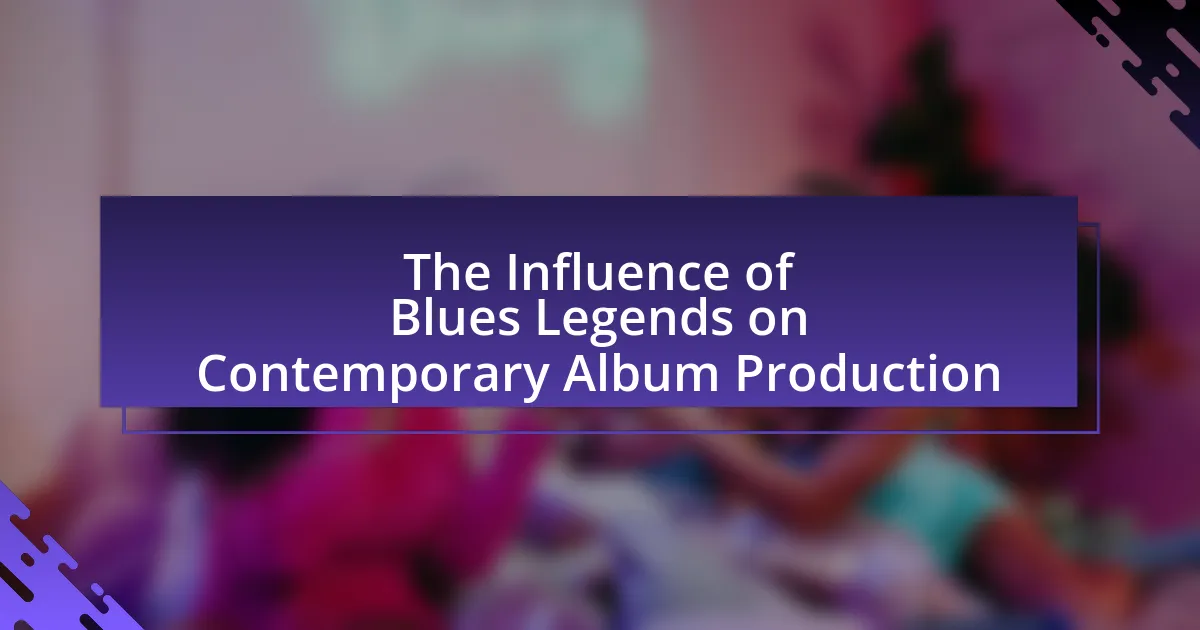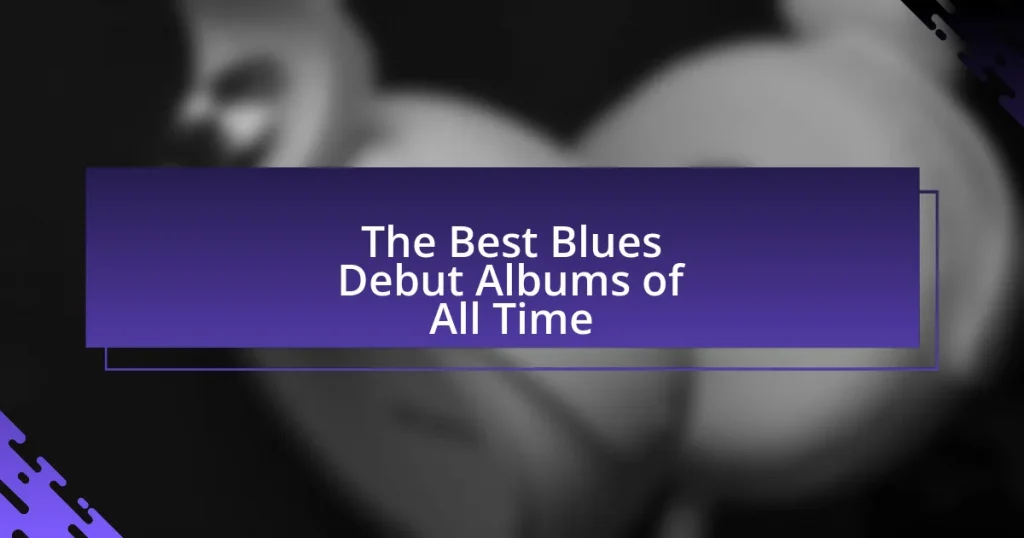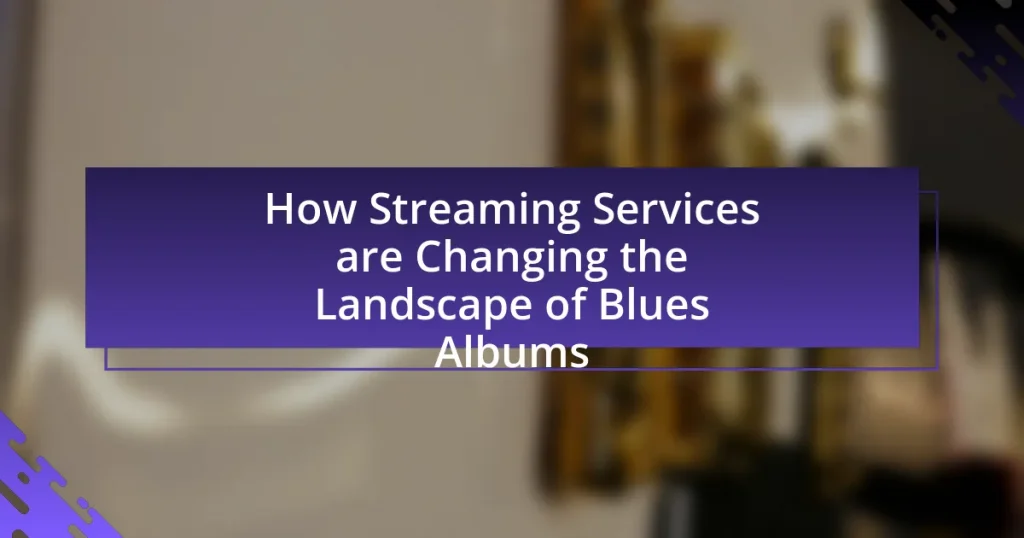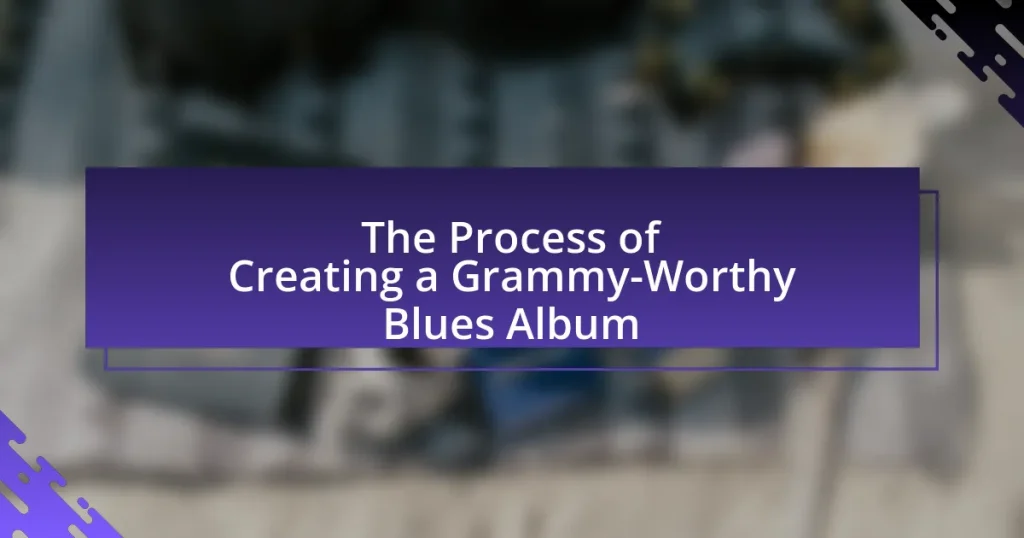The article examines the significant influence of blues legends on contemporary album production, highlighting how foundational musical elements, emotional depth, and innovative techniques established by artists like B.B. King and Muddy Waters continue to shape modern music. It discusses the persistence of the twelve-bar blues structure, expressive guitar solos, and emotional storytelling in contemporary songwriting, as well as the challenges producers face in integrating blues influences while maintaining authenticity. Additionally, the article explores how collaborations between contemporary artists and blues legends enhance production quality and the importance of preserving the cultural legacy of blues in today’s music landscape.
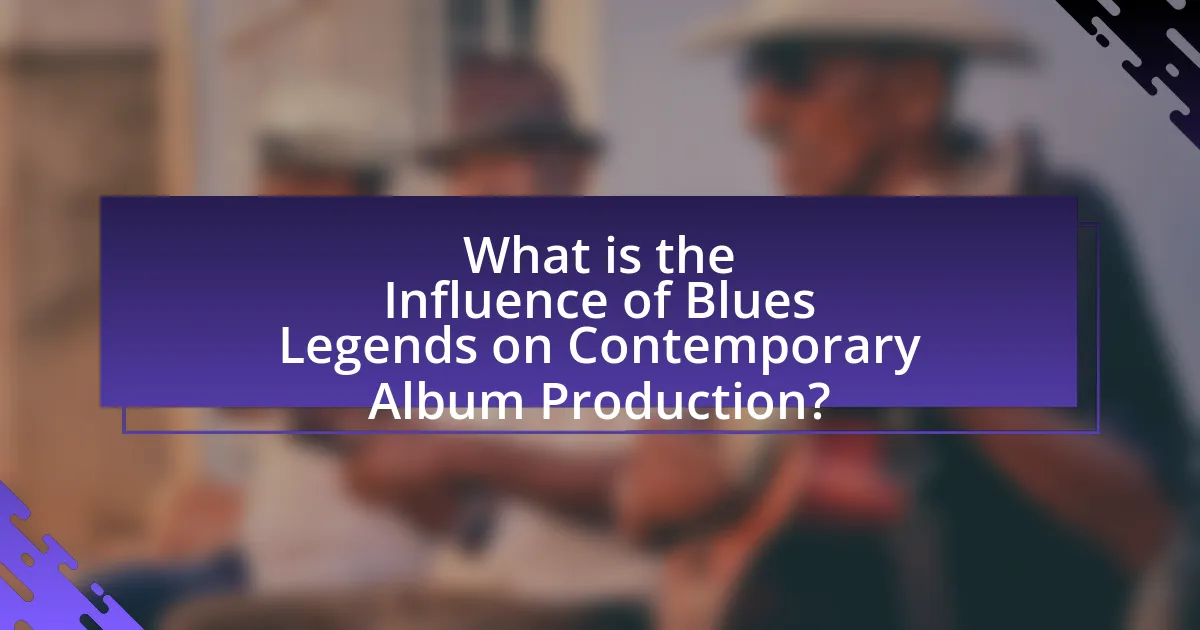
What is the Influence of Blues Legends on Contemporary Album Production?
Blues legends significantly influence contemporary album production through their foundational musical elements, emotional depth, and innovative techniques. Artists like B.B. King and Muddy Waters established the twelve-bar blues structure, which remains a staple in modern music genres, including rock and pop. Their use of expressive guitar solos and vocal styles has been adopted by contemporary musicians, enhancing emotional resonance in albums. For instance, the incorporation of blues scales and improvisation techniques can be seen in the works of artists such as Eric Clapton and Gary Clark Jr., who credit blues legends as key inspirations. This lineage not only preserves the blues tradition but also enriches the sonic landscape of contemporary music, demonstrating the enduring legacy of blues legends in shaping album production today.
How have blues legends shaped the sound of modern music?
Blues legends have profoundly shaped the sound of modern music by introducing fundamental elements such as expressive guitar techniques, emotional vocal delivery, and the twelve-bar blues structure. Artists like B.B. King and Muddy Waters pioneered guitar solos that emphasized bending notes and using vibrato, techniques that are now staples in rock, jazz, and pop music. Additionally, the emotional depth conveyed in blues lyrics has influenced countless songwriters across genres, fostering a focus on storytelling and personal experience. The twelve-bar blues form has also served as a foundational template for various musical styles, including rock and roll, which emerged in the 1950s, drawing directly from blues traditions. This direct lineage is evident in the works of modern musicians like Eric Clapton and John Mayer, who cite blues legends as key influences in their music.
What specific elements of blues music are evident in contemporary albums?
Contemporary albums prominently feature elements of blues music such as expressive guitar solos, call-and-response vocal patterns, and themes of hardship and resilience. These elements are rooted in the traditional blues genre, which emphasizes emotional storytelling and musical improvisation. For instance, artists like Gary Clark Jr. and Joe Bonamassa incorporate classic blues guitar techniques and lyrical motifs that reflect personal struggles, mirroring the foundational aspects of blues legends like B.B. King and Muddy Waters. Additionally, the use of 12-bar blues structures remains prevalent in modern compositions, showcasing the enduring influence of blues on today’s music landscape.
How do blues legends inspire the songwriting process in today’s artists?
Blues legends inspire today’s artists by providing a foundational emotional depth and storytelling technique that enhances contemporary songwriting. Artists often draw from the raw, authentic experiences expressed in blues music, which emphasizes themes of struggle, love, and resilience. For instance, musicians like Gary Clark Jr. and Joe Bonamassa incorporate blues elements into their work, reflecting the influence of legends such as B.B. King and Muddy Waters. This connection is evident in the lyrical content and musical structure of their songs, which often echo the improvisational style and emotional intensity characteristic of classic blues. The enduring legacy of blues is also supported by the fact that many contemporary artists cite these legends as key influences in interviews, demonstrating the direct impact of blues on their creative processes.
Why is the legacy of blues legends important for contemporary producers?
The legacy of blues legends is crucial for contemporary producers because it provides foundational musical elements and emotional depth that shape modern genres. Blues legends like B.B. King and Muddy Waters established key techniques such as call-and-response patterns and expressive guitar solos, which are prevalent in today’s music. Their influence is evident in various genres, including rock, jazz, and hip-hop, where producers often sample or draw inspiration from blues motifs. This connection not only enriches the sound but also fosters a cultural continuity that resonates with audiences, ensuring that the emotional storytelling inherent in blues remains relevant.
What role do blues legends play in the creative decisions of producers?
Blues legends significantly influence the creative decisions of producers by serving as a source of inspiration and authenticity in music production. Producers often draw from the stylistic elements, emotional depth, and storytelling techniques that characterize the works of these iconic artists, such as B.B. King and Muddy Waters. For instance, the use of traditional blues scales, instrumentation, and lyrical themes in contemporary music can be traced back to the foundational work of these legends, which helps producers create a sound that resonates with both historical significance and modern relevance. This connection not only enhances the artistic integrity of the music but also appeals to audiences who value the roots of the genre.
How does the historical context of blues influence current production techniques?
The historical context of blues significantly influences current production techniques by establishing foundational elements such as improvisation, emotional expression, and the use of specific instrumentation. Blues music, originating in the late 19th and early 20th centuries, emphasized raw emotional delivery and storytelling, which continue to shape modern production approaches that prioritize authenticity and emotional resonance. For instance, contemporary producers often incorporate techniques like live recording sessions and analog equipment to capture the organic sound characteristic of early blues recordings, such as those by Robert Johnson and B.B. King. This connection to the past not only informs the sonic quality of current music but also encourages artists to draw on the blues’ rich narrative tradition, ensuring that the emotional depth and cultural significance of the genre remain integral to modern music production.
What are the key characteristics of blues music that persist in modern production?
The key characteristics of blues music that persist in modern production include the use of 12-bar structure, expressive guitar solos, and themes of hardship and emotion. The 12-bar blues progression remains foundational in many contemporary genres, influencing artists across rock, jazz, and pop. Expressive guitar solos, often featuring techniques like bending and sliding, continue to be a hallmark in modern music, showcasing emotional depth. Additionally, the lyrical focus on personal struggles and resilience resonates in today’s songwriting, reflecting the blues’ historical roots in African American experiences. These elements demonstrate the enduring legacy of blues music in shaping contemporary soundscapes.
How do rhythm and instrumentation from blues influence contemporary genres?
Rhythm and instrumentation from blues significantly influence contemporary genres by providing foundational elements such as the twelve-bar structure and the use of specific chord progressions. Contemporary genres like rock, jazz, and hip-hop often incorporate these blues elements, which enhance their musical complexity and emotional depth. For instance, rock music frequently utilizes the blues scale and shuffle rhythm, evident in the works of artists like Eric Clapton and The Rolling Stones, who have cited blues legends as major influences. Additionally, hip-hop artists often sample blues tracks, integrating the genre’s emotive guitar riffs and rhythmic patterns into their beats, as seen in the works of Jay-Z and Kanye West. This cross-genre blending illustrates the enduring legacy of blues in shaping modern music.
What vocal techniques from blues are adopted by modern artists?
Modern artists adopt several vocal techniques from blues, including call-and-response patterns, vocal growls, and expressive phrasing. Call-and-response, a foundational element in blues, allows artists to create a dialogue within their music, enhancing emotional engagement. Vocal growls, often used by blues singers to convey raw emotion, have been embraced by contemporary genres like rock and hip-hop, adding a gritty texture to performances. Expressive phrasing, characterized by bending notes and varying dynamics, allows modern artists to convey deeper feelings, mirroring the emotional depth found in classic blues performances. These techniques have been validated through the works of artists such as Adele and Gary Clark Jr., who incorporate these elements into their music, showcasing the enduring influence of blues on contemporary vocal styles.
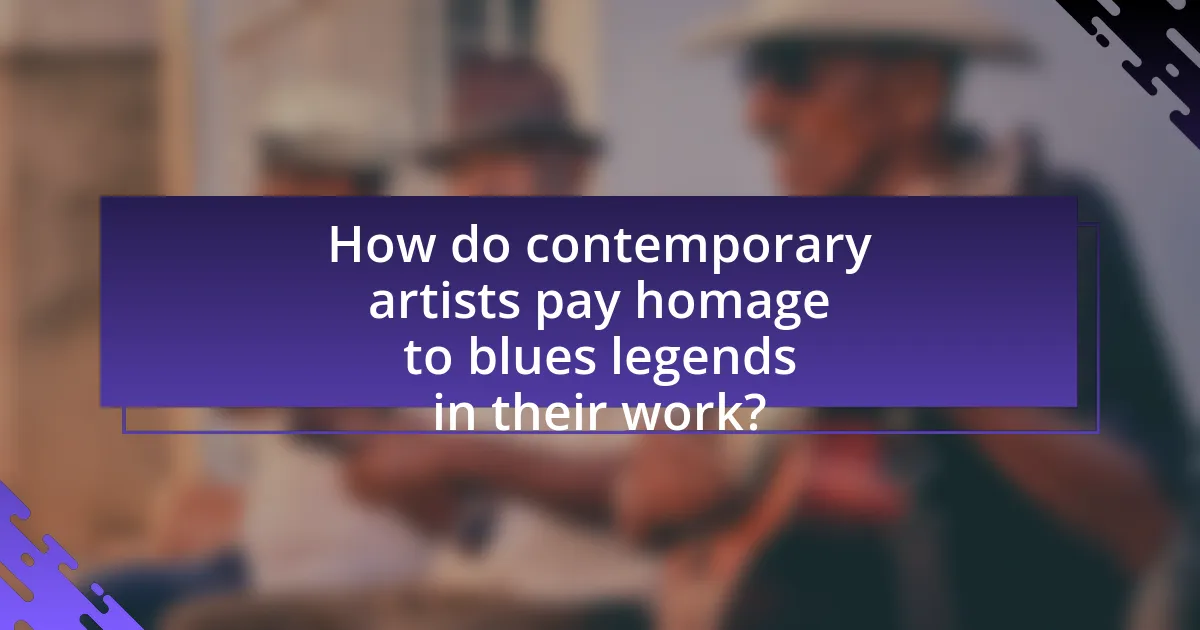
How do contemporary artists pay homage to blues legends in their work?
Contemporary artists pay homage to blues legends by incorporating their musical styles, themes, and techniques into their own work. For instance, artists like Gary Clark Jr. and Joe Bonamassa blend traditional blues elements with modern genres, showcasing the influence of legends such as B.B. King and Muddy Waters. Additionally, many contemporary musicians reference blues legends in their lyrics and album artwork, creating a direct connection to the historical roots of the genre. This homage is evident in the resurgence of blues-inspired festivals and collaborations, where contemporary artists celebrate the legacy of blues icons, ensuring their contributions remain relevant in today’s music landscape.
What are some notable examples of contemporary albums influenced by blues legends?
Notable examples of contemporary albums influenced by blues legends include “Blues of Desperation” by Joe Bonamassa and “The Last Waltz” by The Band, which features blues-infused rock elements. Joe Bonamassa’s album showcases traditional blues guitar techniques and songwriting reminiscent of legends like B.B. King and Muddy Waters. Similarly, “The Last Waltz” incorporates blues influences through its collaborations with artists such as Muddy Waters and Eric Clapton, highlighting the genre’s impact on rock music. These albums exemplify how contemporary artists draw inspiration from the foundational elements established by blues legends.
How do these albums incorporate traditional blues elements?
These albums incorporate traditional blues elements through the use of classic chord progressions, call-and-response vocal techniques, and the incorporation of blues instrumentation such as harmonicas and slide guitars. For instance, many contemporary artists draw from the 12-bar blues structure, which is foundational in traditional blues music, allowing them to create a familiar yet modern sound. Additionally, the emotional storytelling found in the lyrics often mirrors the themes of hardship and resilience prevalent in classic blues songs, further connecting the new works to their historical roots.
What themes from blues legends are prevalent in these contemporary works?
Contemporary works often reflect themes of struggle, heartache, and resilience that are prevalent in the music of blues legends. These themes resonate through lyrics that explore personal and societal challenges, mirroring the emotional depth found in the works of artists like B.B. King and Muddy Waters. For instance, the exploration of love lost and the pain of betrayal are common motifs in both classic blues and modern interpretations, as seen in the music of contemporary artists such as Gary Clark Jr. and Joe Bonamassa. Additionally, the theme of overcoming adversity is a significant thread, with many contemporary songs echoing the blues tradition of finding strength in hardship, which is a hallmark of the genre’s history.
How do collaborations between contemporary artists and blues legends impact album production?
Collaborations between contemporary artists and blues legends significantly enhance album production by merging traditional blues elements with modern musical styles. This fusion often results in innovative soundscapes that attract diverse audiences, as seen in projects like “Raising Sand,” where Robert Plant and Alison Krauss blended bluegrass and blues, earning multiple Grammy Awards. Such collaborations also provide contemporary artists with access to the rich history and authenticity of blues, allowing them to incorporate genuine emotional depth into their work. The influence of blues legends can elevate the production quality and artistic credibility of contemporary albums, as evidenced by the resurgence of interest in blues-inspired music in recent years.
What benefits do contemporary artists gain from collaborating with blues legends?
Contemporary artists gain significant benefits from collaborating with blues legends, including enhanced credibility, access to a rich musical heritage, and increased exposure to diverse audiences. Collaborating with established blues legends lends authenticity and respect to contemporary artists, as these legends often have a storied history and deep-rooted influence in the music industry. This partnership allows contemporary artists to tap into the emotional depth and storytelling tradition inherent in blues music, enriching their own creative expression. Furthermore, collaborations can lead to cross-generational fan engagement, as blues legends often have loyal followings that contemporary artists can attract, thereby expanding their reach and marketability.
How do these collaborations influence the production process?
Collaborations with blues legends significantly enhance the production process by integrating their unique musical styles and expertise, which enriches the overall sound and authenticity of contemporary albums. These collaborations often lead to innovative arrangements and production techniques, as established artists bring their seasoned perspectives and creative approaches to the studio. For instance, the involvement of blues legends can introduce traditional elements that resonate with audiences, thereby increasing the album’s appeal and marketability. This influence is evident in projects like Eric Clapton’s collaborations with B.B. King, where the blending of their distinct styles resulted in critically acclaimed works that showcased both artists’ strengths while pushing the boundaries of contemporary blues music.

What challenges do contemporary producers face when integrating blues influences?
Contemporary producers face several challenges when integrating blues influences, primarily due to the genre’s deep-rooted traditions and evolving audience expectations. One significant challenge is balancing authenticity with modern production techniques; producers must respect the historical context of blues while appealing to contemporary listeners who may prefer polished sounds. Additionally, the limited commercial viability of blues can deter producers from fully embracing its elements, as mainstream trends often prioritize genres with broader market appeal. Furthermore, the complexity of blending blues with other genres, such as hip-hop or electronic music, requires a nuanced understanding of both styles to create a cohesive sound. These challenges highlight the intricate dynamics producers navigate when attempting to honor blues influences in today’s music landscape.
How do producers balance authenticity with modern trends in album production?
Producers balance authenticity with modern trends in album production by integrating traditional musical elements with contemporary techniques. This approach allows them to maintain the essence of the original sound while appealing to current audiences. For instance, many producers draw inspiration from the recording methods used by blues legends, such as live recording sessions and minimalistic instrumentation, while incorporating modern technology like digital editing and production software. This blend not only preserves the authenticity of the genre but also enhances the listening experience for a new generation, as seen in albums that successfully fuse classic blues styles with modern genres like rock and hip-hop.
What strategies can producers use to maintain the essence of blues while appealing to contemporary audiences?
Producers can maintain the essence of blues while appealing to contemporary audiences by integrating traditional blues elements with modern production techniques. This approach includes using authentic instrumentation, such as electric guitars and harmonicas, alongside contemporary sounds like electronic beats and synthesizers. For instance, artists like Gary Clark Jr. successfully blend classic blues guitar riffs with modern rock and soul influences, attracting a diverse audience. Additionally, collaborating with contemporary artists across genres can introduce blues to new listeners while preserving its core emotional themes. This strategy has been evident in projects like the “Blues and Soul” collaboration between blues musicians and hip-hop artists, which has garnered significant attention and appreciation from both blues purists and modern music fans.
How do producers navigate the expectations of fans of both blues and modern music?
Producers navigate the expectations of fans of both blues and modern music by blending traditional blues elements with contemporary sounds. This approach allows them to honor the roots of blues while appealing to the evolving tastes of modern audiences. For instance, producers often incorporate classic blues instrumentation, such as guitar riffs and harmonica, alongside modern production techniques like electronic beats and digital effects. This fusion not only retains the authenticity of blues but also enhances its accessibility to a broader audience. Successful examples include artists like Gary Clark Jr. and Joe Bonamassa, who have effectively merged blues with rock and pop influences, demonstrating that a thoughtful integration of styles can satisfy diverse fan bases.
What are the common pitfalls in attempting to replicate blues influences in modern albums?
Common pitfalls in attempting to replicate blues influences in modern albums include superficial imitation of blues elements, lack of authenticity, and failure to understand the cultural context of the genre. Superficial imitation occurs when artists focus solely on replicating musical techniques, such as specific chord progressions or guitar riffs, without grasping the emotional depth and storytelling inherent in blues music. This often leads to a product that feels hollow and lacks the soul of traditional blues.
Lack of authenticity arises when modern artists do not connect personally with the blues tradition, resulting in music that feels contrived or disingenuous. For instance, artists who adopt blues styles without a genuine appreciation for its history may produce work that fails to resonate with audiences familiar with the genre’s roots.
Additionally, failing to understand the cultural context can lead to misrepresentation of the blues, which is deeply intertwined with African American history and experiences. This misrepresentation can alienate listeners and diminish the genre’s significance. Historical examples, such as the backlash against white artists who commercialized blues without acknowledging its origins, illustrate the importance of respecting the genre’s legacy.
How can producers avoid clichés when incorporating blues elements?
Producers can avoid clichés when incorporating blues elements by focusing on innovative arrangements and unique instrumentation. By experimenting with non-traditional instruments or blending genres, producers can create fresh sounds that honor the blues without resorting to overused tropes. For instance, incorporating electronic elements or world music influences can provide a modern twist while maintaining the emotional depth characteristic of blues. Historical context shows that artists like Gary Clark Jr. and Alabama Shakes have successfully integrated diverse styles, demonstrating that originality can coexist with blues traditions.
What lessons can be learned from successful integrations of blues in contemporary music?
Successful integrations of blues in contemporary music demonstrate the importance of emotional authenticity and musical versatility. Artists like Gary Clark Jr. and Joe Bonamassa have effectively blended blues with rock, soul, and R&B, showcasing how traditional blues elements can enhance modern genres. This integration not only preserves the essence of blues but also attracts diverse audiences, as evidenced by Clark’s Grammy-winning album “Blak and Blu,” which incorporates various styles while maintaining a blues foundation. Furthermore, the collaboration between blues musicians and contemporary artists, such as the partnership between B.B. King and U2 on “When Love Comes to Town,” illustrates the potential for cross-genre innovation, expanding the reach and relevance of blues in today’s music landscape.
What best practices can contemporary producers adopt from blues legends?
Contemporary producers can adopt the practice of emotional authenticity from blues legends, who emphasized genuine expression in their music. Blues artists like B.B. King and Muddy Waters conveyed deep personal experiences and emotions, which resonated with audiences and created lasting connections. This focus on authenticity can enhance the emotional depth of contemporary productions, making them more relatable and impactful. Additionally, blues legends often utilized simple yet powerful arrangements, allowing the core message of the music to shine through, a technique that modern producers can implement to maintain clarity and focus in their work.
